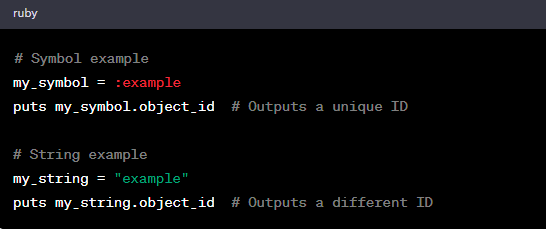Question 1: Explain the Difference Between Symbols and Strings in Ruby
Define symbols and strings in Ruby:
In Ruby, both symbols and strings are fundamental data types. Strings are sequences of characters, enclosed within either double ("") or single ('') quotes, and are commonly used to represent text. On the other hand, symbols are lightweight and immutable, represented by a colon followed by a name (e.g., :my_symbol). Symbols are primarily used as identifiers and don't represent text content.
Highlight the key differences between symbols and strings:
- Immutability: One of the most significant distinctions is immutability. Once a symbol is defined, it cannot be altered, making it ideal for representing static, unchanging data. Strings, conversely, are mutable and can be modified.
- Memory Efficiency: Symbols are more memory-efficient because they are stored in a single location and reused, reducing memory consumption. Strings, in contrast, create new objects when defined, potentially using more memory.
- Usage: Symbols are typically employed as keys in hashes and to represent concepts that should remain constant, such as method names. Strings are better suited for variable data and dynamic content, such as user input or display text.
Provide a sample code snippet to illustrate the concept:

Explain when to use symbols and when to use strings:
In practice, use symbols when you need to represent static, unchanging data, such as keys in a hash or method names. On the other hand, use strings for variable data and dynamic content, like user input or display text.
Question 2: What Is the Difference Between Procs and Lambdas in Ruby
Define Procs and Lambdas in Ruby:
Procs and Lambdas are both objects that represent blocks of code in Ruby. They are often referred to as "closures," as they can encapsulate a chunk of code and be passed around like variables.
Compare and contrast Procs and Lambdas, focusing on their behavior and usage:
- Behavior: Procs are more flexible when it comes to handling the number of arguments passed to them. Lambdas, however, are strict and require the correct number of arguments.
- Return behavior: Lambdas use a strict return, meaning they return the result of the lambda expression itself. Procs may return from the enclosing method in which they are defined, potentially causing unexpected behavior.
- Usage: Procs are more lenient and can be used in a wider range of scenarios. Lambdas are often preferred when strict argument handling and return behavior are required, such as when validating data.
Include code examples to demonstrate the differences:

Discuss practical scenarios where each should be used:
Lambdas should be used when you need strict argument handling and return behavior, such as when validating data before processing it. Procs are valuable when you require more flexibility, like defining a block for iterating over a collection, where returning from the enclosing method is not a concern.
Question 3: Explain Object-Oriented Programming (OOP) in Ruby
Provide an overview of Object-Oriented Programming (OOP) concepts:
Object-Oriented Programming is a programming paradigm that revolves around the concept of objects. Objects are instances of classes and contain both data (attributes) and methods (functions) that operate on that data. OOP promotes concepts like encapsulation, inheritance, and polymorphism to structure code efficiently and foster code reuse.
Describe how Ruby implements OOP principles:
Ruby is a pure object-oriented language where everything is an object. It implements OOP principles by allowing the creation of classes, the definition of methods, and the instantiation of objects. Ruby embraces the dynamic and open nature of OOP, making it versatile and conducive to rapid development.
Discuss key OOP features in Ruby, such as classes, objects, inheritance, and modules:
- Classes: Classes are the blueprints for creating objects. They define the attributes and behaviors that their instances will have.
- Objects: Objects are instances of classes, created from these blueprints. They encapsulate data and behavior.
- Inheritance: Inheritance enables one class to inherit attributes and methods from another class. This fosters code reuse and abstraction.
- Modules: Modules are used for code organization and as mixins to add functionality to classes. They allow you to share code between classes without the need for inheritance.
Include code snippets to illustrate OOP concepts in Ruby:

Question 4: What Are Ruby Gems, and How Do They Work?
Define Ruby gems and their role in Ruby development:
Ruby gems are packages or libraries that provide reusable code and functionality. They simplify the sharing of code and allow developers to extend Ruby's capabilities easily. Think of them as LEGO pieces that you can add to your projects to save time and effort.
Explain the process of installing, using, and managing gems:
To use a gem, you typically install it using the gem command, which retrieves the gem from the RubyGems repository. Once installed, you can require the gem in your code using require. To manage gems, developers often rely on tools like Bundler, which helps ensure that your project has the necessary dependencies and avoids version conflicts.
Discuss the importance of gem management, version control, and dependencies:
Effective gem management is crucial for maintaining a stable and maintainable codebase. By specifying the required gems and their versions in your project's configuration, you ensure that your application runs reliably, even as gems are updated. It also helps prevent version conflicts between different gems, which can lead to compatibility issues.
Mention some popular Ruby gems and their use cases:
- Rails: Ruby on Rails is a full-stack web application framework, simplifying the development of web applications.
- Devise: Devise is a flexible and customizable authentication solution for Rails applications, making it easy to add user authentication features.
- Rspec: Rspec is a popular testing framework for behavior-driven development (BDD) that helps ensure your code is functioning as expected.
Question 5: How Does Exception Handling Work in Ruby?
Define exceptions and the need for exception handling:
Exceptions are events that occur during the execution of a program, disrupting the normal flow of code. These can range from runtime errors, such as division by zero, to anticipated issues like file not found. Exception handling is a mechanism for gracefully managing and recovering from these disruptions, ensuring that your program doesn't crash and can respond intelligently to unexpected issues.
Explain the try-catch mechanism in Ruby using begin, rescue, and ensure blocks:
In Ruby, exception handling is accomplished through begin, rescue, and ensure blocks. The begin block encloses the code that might raise an exception, and the rescue block handles the exception when it occurs. The ensure block contains code that should always run, exception or not.
Provide examples of common exceptions and how to handle them:

Discuss best practices for effective exception handling in Ruby:
- Handle exceptions at the appropriate level: Ensure that you handle exceptions where you can take meaningful action or report errors. Avoid rescuing all exceptions at the top level, as it can mask bugs.
- Provide meaningful error messages: When rescuing exceptions, provide clear and informative error messages that aid in debugging.
- Log exceptions for debugging: In addition to user-friendly error messages, consider logging exceptions for debugging purposes. Logging can help you trace the root cause of issues efficiently.
Conclusion
In this blog post, we've delved into five pivotal Ruby interview questions, covering topics such as symbols and strings, Procs and Lambdas, Object-Oriented Programming, Ruby Gems, and Exception Handling. Understanding these topics is not only essential for acing your Ruby interviews but also for becoming a proficient Ruby developer.
As you embark on your journey to mastering Ruby and preparing for interviews, remember that practice is key. Apply this knowledge in your coding projects, explore Ruby's vast ecosystem of libraries and tools, and continuously seek opportunities to enhance your skills.



